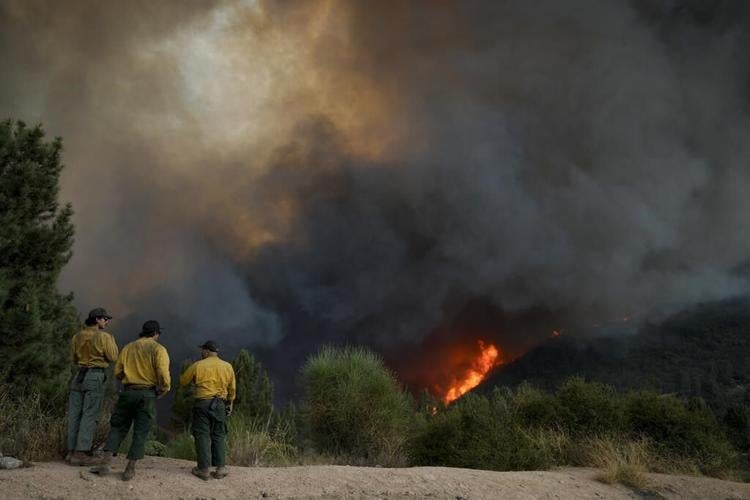A days-long heat wave with triple-digit temperatures prompted hundreds of residents to evacuate as an out-of-control wildfire in the foothills of a national forest east of Los Angeles threatened tens of thousands of buildings.
About 65 miles east of Los Angeles, the so-called Line Fire was blazing along the boundary of the San Bernardino National Forest. By Sunday morning, the fire had burned around 27 square miles of chaparral and grass, covering the region with a dense layer of black smoke.
According to the National Weather Service, the fire burned so fiercely on Saturday that it produced its own pyroculumus cloud weather systems, which resembled thunderstorms and may bring more difficult circumstances including strong winds and lightning strikes. According to authorities, firefighters encountered mountainous terrain that hindered their ability to contain the fire. This Sunday afternoon, the fire was still out of control.
After declaring a state of emergency on Saturday night, county officials ordered the evacuation of Running Springs, Arrowbear Lake, the region east of Highway 330, and other sites.
Steven Michael King, a resident of Running Springs, stated that he had intended to remain until Sunday morning when the fire erupted in order to battle it and assist his neighbors.
He prepared his home to stave against fire damage, but he ultimately made the decision to leave since he was afraid that smoke might prohibit him from subsequently escaping.
“The question was, which is worse—being in a shelter or being trapped?” he posed on Sunday outside of an evacuation center. “I had to make a quick decision when the conditions changed; only a few packs and everything fits in a shopping cart.”
Michael Lee, a homeowner of Arrowbear Lake, claimed he walked out of his house on Saturday afternoon with his dog. Photographer Lee arrived at the Highland evacuation center over seven hours after turning around to acquire a camera.

Lee stated, “I want to go back home,” as he sat in his car outside the evacuation center. “This triple-digit weather is awful.”
Three firemen had been hurt, according to state firefighters, and over 35,000 buildings, including single- and multi-family residences and commercial buildings, were under danger. It could be much harder to contain the fire because of the thunderstorms that are predicted for later in the day.
In a Sunday morning bulletin, state firefighters warned that “afternoon thunderstorms could cause new ignitions and potentially influence activity around the fire perimeter.” “For the next few days, firefighters are expected to face challenges from hot, dry conditions combined with thunderstorms.”
The impacted region is close to little mountain communities in the San Bernardino National Forest, where people from Southern California go mountain biking and skiing in the summer and winter. Running Springs may be reached by road from Big Bear, a well-known ski resort town.
A worker at Noah’s Restaurant in San Bernardino’s downtown, Joe Franco claimed his pals in the nearby evacuation zones were preparing to depart at any time. Downtown San Bernardino was already covered in smoke from the fire, according to Franco.
Regarding his buddies, Franco remarked, “They’re just kind of hanging on tight and getting their stuff ready to move.” “They usually come here, but not many people are coming today.”
The Redlands Unified School District cancelled Monday’s classes for almost 20,000 pupils due to the fire. San Bernardino County was placed under a state of emergency on Saturday night by Governor Gavin Newsom.
About 4,000 people were being forced to flee as a result of a minor grass fire that broke out in Clearlake City, 110 miles north of San Francisco, on Sunday afternoon. The fire was also destroying buildings.
At least thirty residential and business structures were reported to be on fire by officials. On Sunday afternoon, firefighters reported that they were making progress against the fire.
On Sunday, more firemen were anticipated to arrive in San Bernardino County. According to state officials, the area’s vegetation is extremely dry, the temperature rose beyond 100 degrees on Saturday, and the relative humidity made it perfect for the fire to spread. The cause of the Thursday night fire is being looked into.
State firemen said that around 600 firefighters were fighting the fire, assisted by additional aircraft and water-dropping helicopters hovering above homes and slopes wildfire. Calls for further information regarding three wounded firefighters were not answered by Cal Fire authorities on Sunday.
Thick clouds of smoke spiraled out from the fire, and flames topped the peaks on the hillsides. There were no houses or other buildings damaged or destroyed.
According to the National Weather Service, a temperature of 112 degrees Fahrenheit was recorded in downtown Los Angeles on Friday, making it the third occasion that such a high has been attained there since 1877.






